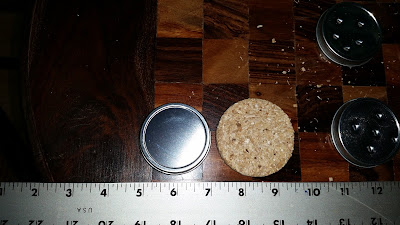A recent thread on The Hungry Onion about electric smokers got me to thinking about finding an alternative to bisquettes for those times that I may be out or when I want to use something different for smoke than what's available (herbs, tea, other woods etc...). I started looking around and found these 1 ounce flat metal tins on Amazon (often sold as containers for homemade lip balms) that are close in dimensions to a bisquette (about 3/8" less in diameter and 1/16" thicker) and decided to give them a try.
Here is one of the tins next to a bisquette. Using the reamer tool on a Swiss army knife I punched several holes in the lids (ended up with 9 per tin). I had been saving the left-over wood chips in the bottom of bisquette trays and put about a teaspoon of chips in each tin, closed them up and loaded them in the bisquette hopper. The test run went really well, the control box advanced the tins down the ramp to the burner plate with zero issues. Due to the slightly lower diameter each tin ended up spending a total of 40 minutes on the burner plate, half on and half off. I opted not to fill the catch bowl with water as I figured that could damage the tins or make then difficult to open later for reuse. When I did open the tins later all of the chips had burned up. Hopefully I'll be able to fully load the tins with wood chips this weekend and see how they do in an actual cook!
Please keep in mind that the use of these tins as a bisquette alternative is an experiment, try at your own risk!



